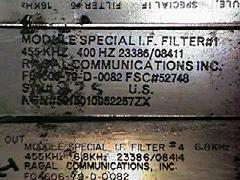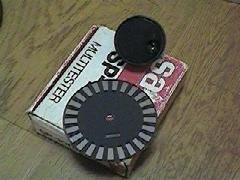RACAL RA6790/GM Receiver

I didn't even know the name of RACAL until recently.
But I got interested in the receiver when I found the name
in the review of AR7030 and saw pictures on some web pages.
In summer of 1998 I found one on sale at the biggest ham fest in JA.
I just couldn't stop purchasing it.
Some circuit description
This is a dual conversion receiver with the 1st IF of 45MHz and
the 2nd IF of 455kHz. It has no RF amp befor the 1st mixer.
The mixer is sealed but I read somewhere that it consists of
four MOS FETs. Judging from the info and high level of LO signal,
it seems to be capable of handling strong signal condition.
However, as the gain before the 455kHz filter is relatively high,
it may be suffered from overloading when strong close-in signal
exists in the passband of the roofing filter.
The 455kHz amplification is mostly done by one IC, which is the
same one as used in KWM380.
Product detection is performed by popular MC1496. It also used
in AM mode with amplified and limited IF signal fed as BFO and
realizes so-called syncro-phase detection like Drake R-7 and NRD-525.
The amplification and limiting are done by FM detector IC.

IF/AF board

top view of IF filters

encoder and main tuning knob

LCD
Impression
Filters
Mine has 5 crystal filters( 0.4, 1.4, 3.2, 7.5, 18kHz).
I heard that various filters (different bandwidth/shapefactor/group delay)
can be fitted and some units have mechanical filters, but this seems to be
the most popular configuration.
The 3.2kHz filter is a bit too wide for crowded band conditon
but the recovered audio is very very good. You can hear the
subtle difference of stations.
In SSB mode only one bandwidth can be selected.
The receiver sounds very good in AM mode, too with 6.8kHz(nominal.
7-8kHz actual) though that filter is also a little too wide
in most condition.
They are all good filters and have good skirt selectivity
but the ultimate rejection of the overall receiver is not
so good. I don't know that is common to 6790s or mine is faulty.
I want to improve the ultimate rejection.
The BITE(Built-In Test Equipment) function measures bandwidth of
filters inserted and sets BFO offset for SSB modes.
It also reports error code when malfunction is found during
the test, which helps you indentify the board to be replaced.
Tuning
Tuning can be done by direct input with the keypad or
by rotating the main tuning knob.
3 tuning steps (1/30/1000Hz) are available.
In SSB mode 30Hz step is adequate but that does not
always tunes to exact kHz. So 25 or 50Hz seems to be more convenient.
It requires modification to the ROM to change tuning steps.
The CPU is MOSTEK 3850. Has anyone done it yet?
AGC
3 AGC time constant and OFF are available but SLOW is way too slow
and MEDIUM is a little too fast. The attack time is long and
it causes pop at the onset of the signal.
The AGC circuit looks complex and I don't fully understand it
but it adopts so-called hang-AGC and you may change hang time
constant as well as release time by changing R and/or C values
for more comfortable AGC action.
to be continued.....




